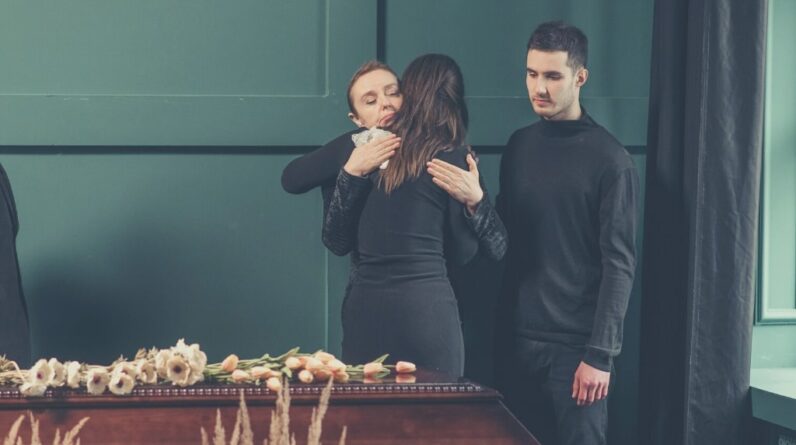
There might be affiliate links on this page, which means we get a small commission of anything you buy. As an Amazon Associate we earn from qualifying purchases. Please do your own research before making any online purchase.
When I was little, my mom was quick to teach me that every occasion had a dress code.
She’d say, “You wear your bathing suit to the beach, you wear your play clothes outside, and you wear your Sunday best or ‘neat’ – formal or modest – clothes for church and wakes.”
As a child, I didn’t know what a wake was exactly, but I was fortunate enough to only attend my first wake (and funeral) when I was in my early twenties.
I knew I had to wear church-like clothes but I also had a feeling that wearing my bright pink top wasn’t appropriate.
Wearing the appropriate attire to a wake is essential to show your respect to the family and honor those who passed. When a loved one passes, it’s normal to wonder how exactly you should navigate wake, funeral, and mourning etiquette.
There’s already enough on your plate, so your outfit for the wake is likely the last thing you’ll think about.
Of course, what you wear depends on various factors like religion and culture, but if you’ve ever wondered “what to wear to a wake,” this is the ultimate guide you need.
What’s a Wake?
When someone we love passes, we have the option of viewing the body, paying our last respects, and celebrating their life with friends and family at the memorial or wake. Different cultures and religions have different concepts of a wake.
You even get something called a living wake, where the soon-to-be-deceased has an opportunity to hang out with their favorite people before passing. Usually, this type of wake happens when the person who is passing has a terminal illness.
So, no matter the religion or culture, your attendance at a wake is to commemorate, mourn, offer condolences, and say farewell. This also means you need to wear the appropriate outfit for the wake.
Here are a few common questions you may have about a wake:
What’s the Difference between a Viewing vs Wake?
The root difference between a viewing and a wake is that wakes originated in the Catholic religion, while viewings are not tied to a specific religion or culture.
While the word “wake” means to stay alert, and the family would usually stay with the body on the first night of the death, it’s also been said that the Irish hold a wake to see if the deceased wakes up (while they drink and commemorate their life).
Why Hold a Wake?
Holding a wake is expected in some cultures, while others use it as an opportunity for family to gather and pay respects.
A wake may replace the funeral, and in our modern world where people may not be religious, it’s a way to say a few words before the burial or cremation.
For those who are religious, a wake is often part of the Christian, Hindu, and Buddhist faiths.
What Happens at a Wake?
Depending on the family, the deceased’s wishes, and their religion or spirituality, a wake may be formal, informal, and even a rowdy party. This will influence what you wear.
A formal wake would call for more formal attire, while an informal wake would perhaps be characterized by a themed dress-code or a “come as you are” guide.
The wake may take place at a funeral home, church, or at the family’s home. If the wake is in a church, your dress-code would also honor the requirements of the religion’s stipulations.
A wake isn’t a funeral, so you should pay special attention to your invitation to the wake. While funerals may allow community members to come and support the family, a wake may be closed to the public, and it’s often by invitation only.
Usually, the wake will happen before the actual funeral. If a public notice has been placed, the public can attend the wake, but if it’s an invitation-only event, you should honor the family’s wishes in terms of what to wear.
The Origins of a Wake & Its Significance for Christians
The first recorded instance of a funeral wake dates back to 6th-century Ireland. The notion of being given a last chance to say goodbye appealed to people from many religions, but Christians especially found the wake relevant and sacred.
Following the death of Christ, it’s said that His family held a wake at the grave site, lingering for three days, which is when Christ rose again.
The wake could then be interpreted to mean the mourners should wait three days to see if their loved one would rise again.
At wakes, the attendees would support the family and the purpose was also to ensure the deceased was really dead.
With the increase in technology, it is no longer likely that someone had a “false death” and could end up being buried alive. So wakes have a more religious and personal function in modern times.
Wakes became more popular in the 1800s in the U.S. Usually, the wake transpired in the deceased’s home.
The deceased is usually dressed in formal attire, placed in their coffin, and the body may be placed “on display” for mourners to pay last respects. More traditional wakes may have a structured approach with keening, poetic laments, and funerary rituals.
Cultural, Religious, Seasonal, and Other Influences on Wakes & What to Wear
There are many different considerations about what to wear to a wake, especially the season, the deceased’s religion or culture, and the family’s requests.
A Christian Wake
Typically, a Christian wake would dictate that men wear a dark-colored suit and dress shoes, while women would be expected to wear dark-colored dresses or skirts, court shoes, and even a hat.
A Buddhist Wake
If your Buddhist friend passes, you should wear plain black or dark-colored clothing and avoid lavish displays like jewelry.
A Hindu Wake
But if you have to attend a Hindu wake, leave your black clothes at home and opt for white instead. Ladies, ensure your arms and knees are covered modestly.
A Muslim Wake
Muslims don’t typically keep a wake, but if you attend their funerals, ensure you dress in dark colors or black with no adornment. The fabric must also be opaque and not have any see-through details. A head-covering for ladies is a must.
A Military Wake
Should you have to attend a military wake, you would dress formally, with a suit for men and a below-the-knee skirt or pants for ladies.
Comrades of the deceased may dress in their military uniforms as a show of respect.
While black remains a popular color, you can combine this with a dark-colored shirt or a white shirt.
A Special Wake
When someone who was part of a community such as bikers, equestrians, or hikers dies, the wake may have some special requirements. The family would guide you in this regard.
It’s traditional for bikers to show up in their biker regalia, while equestrians may show up in their uniforms or riding attire (usually with a horse or two present too).
The Weather
Summer wakes can be tricky as the hot weather may make it unbearable to dress in long sleeves and fully cover arms and necks.
Most Christian wakes will allow ladies to wear a modest sleeveless dress and men to wear short-sleeved shirts, even forgoing the suit jacket.
Ultimately, what you wear is determined by the family or deceased’s wishes, and invitations or notices of the wake may include instructions like wear a sports cap, come in jeans and a white shirt, or dress casually.
Emotions during a Wake and How That Influences How You Dress
What you feel may also influence how you choose to dress. If you know the deceased well and mourn their passing on a personal level, you may choose to dress in their favorite type of outfit, wear black, or even shroud yourself in a veil to hide your grief.
It’s considered rude to wear flashy outfits with large and gregarious prints that attract attention to you during a wake as the attention should be on the family and their loss.
Should you not want to wear black or dark colors, then choose a muted tone of a lighter color to still honor the grieving process.
What to Wear to a Wake: 6 Tips
Let’s dive into the closet to discuss some ideas on what to wear to a typical Christian or modern wake.
For cultural wakes, it’s best to consult the family of the deceased to check what you should wear, but for most wakes, these are safe options to select (unless the deceased is your biker buddy who insisted you show up “with tats on display.”)
Generally, it’s wise to dress according to a business casual look. This is a formal look that calls for structured clothes, jackets, court and dress shoes, and muted colors. Remember, you want to show respect to the deceased’s family.
Be sensitive, it’s not acceptable to just send a text message asking, “Dude, what should I wear to the wake?” Respect cultural conventions, and if you really don’t know what to wear, you can discuss it with the funeral home where the wake is to be held.
1. Clothing Colors
You can wear black, but you can also choose a muted color like burgundy, navy, or brown. A soft print is fine for ladies, but it’s best to leave that leopard print top at home. Neutral colors like gray, dark silver, brown, or black are best and safest.
Soft pastel colors are also suitable for ladies and girls.
2. Shoes
Most wakes are a formal affair, so don’t wear sneakers, boots, or open-toe shoes. Avoid stilettos and rather choose a sensible shoe that’s formal and matches your outfit’s muted tones. If you are a pallbearer, you should also look for shoes with a good grip.
3. Accessories
Keep it simple with accessories. Women can wear a simple bracelet and watch, necklace, wedding rings, and small earrings. Avoid long, dangly earrings. Men typically don’t wear any jewelry other than a watch.
When in doubt, rather don’t wear jewelry at all. A wake isn’t the time to shine.
Ladies typically tie their hair, and for very formal funerals, a woman may wear a hat or a short grieving or mourning veil. Men with long hair should tie their hair, and usually, it’s advised that tattoos be covered.
4. Jackets
In winter, you should choose a muted color jacket that is a tone darker than your clothes or the same tone. Avoid wearing fur coats, which may be upsetting to some at the wake. Don’t wear shiny leather jackets, which aren’t formal attire.
Don’t wear jackets with logos on, which also isn’t formal wear. A sports blazer with minimal design elements can work if you don’t own a suit. However, if you’re a guy, wear a tie.
5. Children’s Clothes
Teenagers should be dressed similarly to adults, following the same rules as adults do for wake clothing.
Toddlers won’t necessarily wear dark or black colored clothing, but you can choose a plain colored outfit for your child.
Leave brightly colored and noise-making toys at home when taking your toddler or baby to a wake.
If your children don’t own a set of formal clothes (or they’ve outgrown theirs), it’s a good idea to choose a simple muted dress, or plain school pants and a white shirt with a tie.
6. What Not to Wear to a Wake
Never wear bright and patterned clothes or open shoes, flip-flops, or boots to a wake. Avoid jackets that have large logos or motifs on them.
And if the family requests a specific type of dress, you should dress according to their wishes.
Other clothing types that aren’t normally worn to a wake include jeans, T-shirts, woolen scarves, shorts, sandals, tennis shoes, and sneakers. Brightly colored socks are also a big no-no.
Men and children should avoid wearing a hat, unless instructed to do so by the hosting family. If everyone wears a hat, you may have to remove it when prayers are said or if you move indoors.
Ensure all clothing is ironed, and avoid wearing any “ripped” fashion items.
Final Thoughts about What to Wear to a Wake
The family of the deceased looks to friends and family for support. This is why you attend a wake, and you should take care in choosing what to wear to a wake. You must show respect, while also honoring the deceased’s wishes.
Ultimately, if you choose plain colors and wear business casual clothes, you should be on the right track. If you’re unsure, discuss the dress code with a member of the family respectfully.
Knowing how to express your condolences takes skill, so check out our guide to condolence messages for the grieving.
And if you’re looking for related posts, be sure to check out these blog posts:







